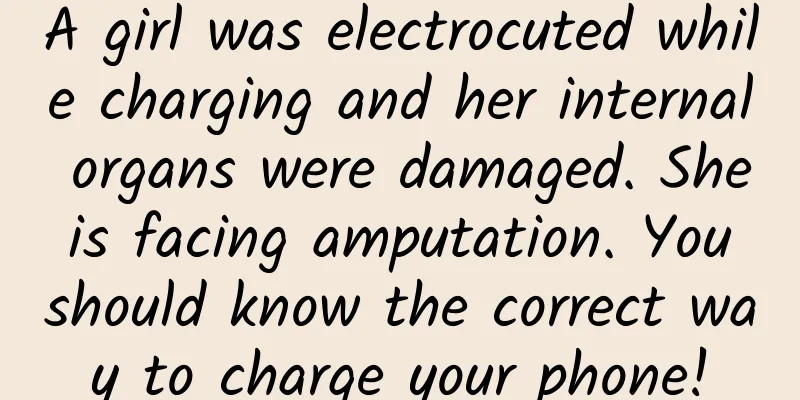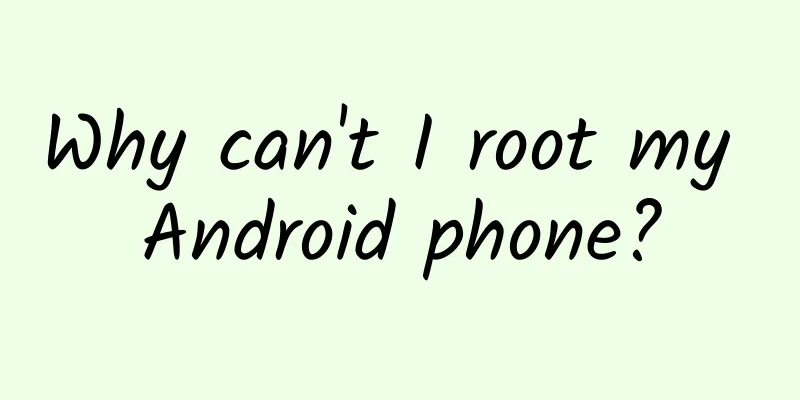A girl was electrocuted while charging and her internal organs were damaged. She is facing amputation. You should know the correct way to charge your phone!

|
Recently, a shocking electric shock tragedy occurred in Shenyang, Liaoning Province. A girl was electrocuted while playing with her mobile phone. Her organs were severely damaged and she is now facing amputation. The girl said that she was playing with her phone while charging it, and she put her feet on the radiator. Suddenly, she felt an electric shock all over her body, and then she lost consciousness and fell to the ground. When she fell, her whole body was stiff and she couldn't move, but she still retained a little consciousness at this time, but she couldn't move at all, and her eyeballs could only move. Later, she fainted completely, and when she woke up again, she was lying in the hospital. Doctors said that because the girl was electrocuted for too long, many of her vital organs were damaged, and her current condition is not optimistic. Although her legs can be saved after treatment, all her toes will have to be amputated because they have all been carbonized. Circuit short circuit is the "real culprit" of mobile phone battery injuries. Dr. Bi Hui, an associate researcher at the Shanghai Institute of Ceramics, Chinese Academy of Sciences, who has been doing lithium battery research for a long time, said that there are four special situations that may have a serious impact on personal safety. Hidden danger 1: Extreme environment Since the safety of electronic products has been difficult to completely solve, there are certain safety risks under extreme conditions. For example, in high temperature and humid environment, the reliability of electronic components will be greatly reduced. Each electronic component has a safe operating temperature range. Exceeding this range may cause the component to be broken down or fail. Under normal circumstances, you will not be electrocuted by touching the charger connector. However, if the charger fails or the protective device is not up to standard, the charger may directly output a high voltage of 220V to the mobile phone, causing electric shock and danger. Hidden danger 2: Lack of circuit protection The original charger is equipped with a transformer, which can automatically adjust even when the voltage is unstable, making it safer. Inferior chargers, especially cheap knockoff chargers, lack circuit protection and cannot guarantee the stability of the current during charging, which can easily burn out the battery, shorten the battery life, and even cause explosion. Hidden danger 3: leakage when charging and making calls Most of the current mobile phones use lithium-ion batteries, and the probability of danger is extremely small (less than 0.3 billionths), but 80% of accidents occur when charging. This is because the voltage of the mobile phone is higher than the standby voltage when charging. If other operations are performed at the same time, the current will be many times higher than usual. If you use a low-quality charger, or the electronic components of the mobile phone are aging or damp, it may cause leakage, and then the current will pass through the human body. Once the current passing through the human body is too large (greater than 50mA) in a short period of time, it may cause death. Hidden danger 4: Accessory short circuit During the charging process of a mobile phone, short circuits between the power supply, the power strip, the two ends of the power adapter, the two ends of the charging cable, and then to the mobile phone connector are also important causes of sudden danger. This is because the change of external voltage and the instability of charging current can cause the circuit to spark and discharge, destroy the insulation layer, and eventually short circuit, endangering life. Short circuit or explosion may occur under extreme conditions, but it is hard to say about the knockoffs. There is a power supply on the chassis of desktop computers, which plays the role of converting AC power into DC power and is responsible for supplying power to the computer motherboard and USB interface. Once there is a problem with the power supply, the high voltage output by the desktop computer directly breaks through the computer motherboard, causing a short circuit, so that the AC power is directly transmitted to the mobile phone through the USB interface. In addition, there may also be a problem with the phone's battery. Nowadays, most of the knockoff mobile phone batteries lack protection circuits, and the capacitance is also falsely marked. In addition, most of the current smart phones have large screens and consume a lot of power, which requires many cells to be connected in series on the mobile phone battery. In order to save costs, some knockoff mobile phone batteries only connect one or two cells in series, which buries hidden dangers to the safety of mobile phones. Shu Luan, head of Shanghai Moore Laboratory and Tianzong Testing Laboratory, which specializes in electronic product testing and certification, said that under normal circumstances, qualified products that have passed 3C tests and certifications, whether mobile phones, chargers or batteries, will have protection circuits. That is, the mobile phone itself has control over the power supply, and can monitor the temperature, current and voltage of the mobile phone in real time. Once an abnormality occurs, it will freeze or stop working. The mobile phone battery itself also has a protection board that can monitor the working status of the battery cell to prevent it from overcharging or overloading. "That is to say, under normal circumstances, as long as one of the three protections of the mobile phone works, there will be no accidents of electric shock or explosion." Shu Luan said that it is only possible to happen in some extreme situations or environments. Extreme voltage and current can cause battery explosion, such as voltage exceeding 9 volts, or current exceeding 3 amperes, but ordinary chargers cannot reach such high current or voltage. Peng Shimeng, a test engineer at the Moore Laboratory of Shenzhen Electronic Product Quality Inspection Center, revealed that only when the mobile phone encounters special circumstances such as high temperature and short circuit, the lithium battery may suddenly charge and discharge sharply, and the stored energy will burst instantly, and finally explode due to overheating. At present, qualified mobile phones on the market have multiple safety designs, which can ensure normal and safe use. Long before the mobile phone came out, the hidden dangers were eliminated when the prototype was designed. For example, considering the problem of mobile phone leakage, the capacitor of the mobile phone itself is usually reduced, or some other components are added to reduce the leakage current. At the same time, in order to prevent the mobile phone from exploding, there will be a decompression valve on the mobile phone, which is equivalent to the valve on the pressure cooker. When it encounters high pressure, it will automatically open to release the internal pressure. In general, qualified mobile phones and supporting facilities will not cause great harm to people. However, several experts said that it is necessary to purchase qualified products produced by regular manufacturers. Charging your phone scientifically should also be done with “small meals and frequent meals” Dr. Bi Hui said that the currently recognized basic principle of lithium-ion batteries is the so-called "rocking chair theory". The charging and discharging of lithium-ion batteries does not achieve electron transfer through traditional methods, but through the entry and exit of lithium ions in the crystals of layered materials, which causes energy changes. Under normal charging and discharging conditions, the entry and exit of lithium ions generally only cause changes in the interlayer spacing, and will not cause damage to the crystal structure. Therefore, from the perspective of the charging and discharging electrochemical process, lithium-ion batteries are an ideal reversible battery. During charging and discharging, lithium ions go back and forth between the positive and negative electrodes of the battery, just like a rocking chair rocking back and forth between the positive and negative electrodes, so some people figuratively call lithium-ion batteries "rocking chair batteries." There are two main safety hazards of lithium-ion batteries: One is to make a phone call or operate a mobile phone APP (smartphone) while charging. Under normal circumstances, there is no safety risk, but we do not recommend this habit. This is because the instantaneous current passing through when making a phone call is large, which is more likely to cause frequent charging and discharging of the battery, and the charger is in an overloaded state for a long time, which increases the heat generation, affecting the performance or life of the battery and charger. At the same time, organic electrolytes are used in lithium-ion batteries. Under high current and high temperature conditions, organic electrolytes will be electrolyzed to produce a large amount of gas, causing the internal pressure of the battery to increase. In severe cases, the shell will break (commonly known as "battery bulge"), causing external short circuit combustion and explosion. Therefore, the safest way to charge a mobile phone is to use an original 3C certified charger to charge the mobile phone that remains turned off, and unplug the charger once it is fully charged. Second, when lithium-ion batteries are charged for a long time and completely exhausted, they will cause overcharging and over-discharging, which will cause permanent damage to the positive and negative electrodes of lithium-ion batteries. From a molecular level, over-discharging will cause excessive release of lithium ions from the negative electrode carbon, causing its layer structure to collapse; overcharging will force too many lithium ions into the negative electrode carbon structure, making some of the lithium ions no longer released. Therefore, overcharging and over-discharging are not conducive to the safe use of lithium-ion batteries. Experiments have verified that starting to charge when the battery capacity is more than 20% remaining can greatly extend the service life of lithium-ion batteries. In other words, lithium-ion battery charging emphasizes "eating small meals more often", and frequent shallow charging and discharging is more helpful to extend its life. As for the voltage and current during the charging process, Dr. Bi Hui explained that the voltage at the front end of the power adapter is 220V, the current is mostly around 0.15A, and the voltage at the back end and the wiring behind is equal to or slightly lower than 5V, which are all within the scope of safe voltage. The rated charging current is 1000 mA-2000 mA. The output voltage of a qualified mobile phone charger is generally a safe extra-low voltage of about 5V, and the maximum contact current from the primary (grid power supply 220V) to the ungrounded accessible parts (USB output port) is 0.25 mA (experiments by the International Electrotechnical Commission show that the current of cardiac fibrillation caused by the human body is 50 mA), and a qualified mobile phone charger isolates the dangerous voltage circuit (grid power supply 220V) from the safe extra-low voltage (USB output port) through reinforced insulation or double insulation, which is safe for the human body. He added that even if you touch the USB port with your hands or mouth, although the human body impedance formed by the hands or mouth to the ground is different, the contact current is slightly different, but it is a very weak and safe current, which generally does not cause electric shock injuries. Electric shock is caused by the passage of electric current through the human body, and the physiological reaction it causes depends on the magnitude and duration of the current value and the path it takes through the human body. The current value depends on the applied voltage, the impedance of the power supply and the impedance of the human body. It takes about 0.5 mA or more to produce a reaction in a healthy human body. For mobile phone chargers that meet national standards, the maximum contact current from the primary (grid power supply 220V) to the ungrounded accessible parts (USB output port) is 0.25 mA, so there is no leakage in the USB port of a qualified charger. ▲Schematic diagram of lithium-ion battery principle Is your charging method safe? Many people are used to charging their mobile phones by connecting them to computers after work and life. Dr. Bi Hui said that using USB to charge a mobile phone through a computer is more harmful than beneficial, because the mobile phone will automatically detect the current condition of the battery, extending the battery life and standby time. However, the use of computers is different. Sometimes the hard disk is suddenly read and written, or the CPU or graphics card works at full frequency when running certain software, which causes great fluctuations in the power output of the USB, making the battery charging very unstable and affecting the battery life. The USB specification stipulates that the rated voltage of USB is 5V and the current is 500mA. As the capacity of lithium-ion batteries increases, the rated current of most mobile phone chargers on the market is above 1000mA, and some can even reach above 2000mA. Therefore, if such mobile phones are charged using a traditional computer USB port, the charging time will obviously be much longer. In addition, when charging a mobile phone through a computer USB port, the rated charging current of the mobile phone battery is higher than the USB power supply current, and the computer USB port is in an overloaded state for a long time, which increases the heat and causes great damage to the electronic components of the computer and mobile phone, affecting their service life. In serious cases, it may also cause electric shock accidents. Shu Luan also said that charging directly through the USB port is not within the scope of national standards or some manufacturers' safety tests. Moreover, due to the complexity of such combinations, it is difficult for manufacturers to test their safety one by one. For example, some people charge directly through the USB port on the car, while others charge directly through the USB port on the socket. It is difficult to define their reliability one by one. Shu Luan suggested that it is best to charge the phone with the original mobile phone charger. Because when they do certification testing on mobile phones, a typical certification method includes charging with a charger. This certification method will be tested more than a hundred times in experiments and by manufacturers in normal tests, and its reliability is higher. |
>>: It turns out that you are this kind of hot pot: How does a self-heating hot pot “self-heat”?
Recommend
Case Review | QQ Browser News New User Retention Growth Methodology
By reviewing a growth case I did last year - the ...
How much does it cost to be an agent of Xianyang e-commerce mini program? What is the price for being an agent of Xianyang e-commerce mini program?
Is it easy to be an agent of Xianyang e-commerce ...
Brand promotion: 23 ways to refine product and brand selling points
The starting point of all businesses is to benefi...
360 N7 mobile phone review: a powerful PUBG mobile phone
For several years, 360 mobile phones have been fo...
How much food can a person eat at one time?
In recent years, news and eating shows about &quo...
Huang Daozhu's latest Baidu screen-dominating article platform, the fastest inclusion takes only 30 seconds
Topic: "Unlocking a new world: the latest Ba...
After Yu Yongfu became the "parent", Amap became a "personal youth"
March 13 (Reporter Zhang Zhichang) Today, when Yu...
7 eating habits that cancer cells love most. Avoid them from now on
Planning and production Author: Pan Zhanhe, Chief...
Does snoring mean you are sleeping well? In fact, it is the enemy of your health.
Author: Lu Xiang, Chief Physician, Shaw Hospital ...
"I am a little girl, but the world is big for me"! Today, let's get to know the cerebral palsy community again
Review expert: Peng Guoqiu, deputy chief physicia...
Be aware that feeling tired for no reason may be a sign of illness!
Some people are full of energy every day, while o...
If I keep exercising, will I still have thick, black hair when I am 70?
Review expert: Peng Guoqiu, deputy chief physicia...
5 Growth Hackers Behind Explosive App Marketing
Facebook acquired MSQRD (Masquerade), a special p...
Tears on the Great Wall, moved from GitHub to GitCafe
GitHub Blog Migration Guide Recently I have found...
Evolution Classroom "Practical Course on How to Sell Good Products on Douyin"
Evolution Classroom "Douyin Good Product Sal...









